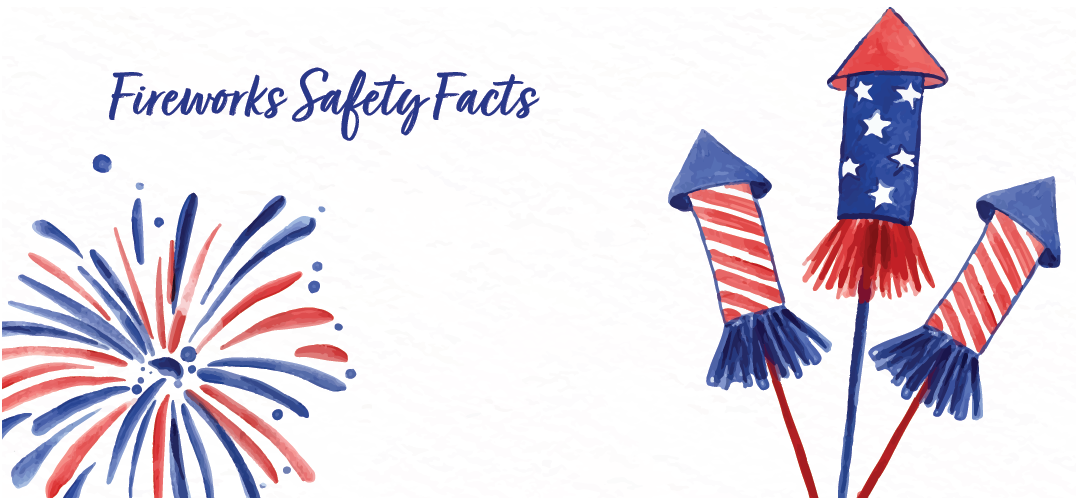
It’s time for the annual fireworks safety reminder.
Every year, the month surrounding July 4th keeps local emergency rooms busy. In the month leading up to the holiday, an average of 180 people go to the E.R. daily thanks to fireworks-related injuries.
Aside from worrying about burns, there are other health concerns to keep in mind, too, like hearing damage and smoke inhalation.
This post will offer safety facts and tips you can distribute to employees so they can safely enjoy the fireworks displays this upcoming weekend.
Whether team members are blasting off their own fireworks or going to a public display, here are some fireworks safety facts to keep in mind:
Surprising Facts About Fireworks
In 2019 alone, there were an estimated 10,000 fireworks-related injuries treated in emergency rooms across the U.S. Of those, 7,300 fireworks-related injuries were in the month window of the 4th of July holiday.
With that in mind, it’s important to keep fireworks safety at the forefront of all Americana-style festivities.
Fireworks are created with chemical reactions that generate the color that produces a spectacular aerial show. While awe-inspiring, these chemical reactions can also cause damage to the human body. A few facts about fireworks to share:
Fact #1: Sparklers are Hotter Than You Think
A single sparkler burns at about 2,000 degrees. That’s hot enough to melt certain metals, according to the National Safety Council.
Fact #2: Every Year, Fireworks Injuries Send People to The ER
On average, 180 people go to the emergency room daily with fireworks-related injuries in the month surrounding July 4th.
Fact #3: Burns Are The Most Common Injury
An estimated 57% of injuries related to fireworks usage are skin burns.
Fact #4: Hands And Fingers Get Burned The Most
Hands and fingers account for 30% of fireworks-related injuries; legs are the second most injured body part.
Fact #5: It’s Best to Skip The Brown Paper Packaged Fireworks
If a retailer tries to sell you fireworks that come packaged in brown paper, don’t buy it. These are for use by professional pyrotechnicians.
Other Health Risks Associated With Fireworks
Aside from the potential of burns, there are other health concerns that you may not think about during a fireworks display. Noise and air quality are two other results of fireworks that often get forgotten prior to launch time.
Here’s how each may impact your health:
Louder-Than-Normal Noise Levels
Fireworks can exceed 140 decibels. Anything that goes 85 decibels and above can damage hearing. To prevent hearing damage, it’s helpful for spectators to wear earplugs or earmuffs to block the noise.
Exposure to loud sounds can lead to:
- Restlessness
- High blood pressure
- Sleep disturbance
- Temporary or permanent hearing loss
The standard noise level set by the Department of Environment and Natural Resources (DENR) for the ambient environment is 60 decibels during the day and 50 decibels at night.
Reduced Air Quality
Once a firework shoots off and explodes, it creates particulate matter that includes smoke, soot, and sometimes dust. Although almost always present in our air, particulate matter may cause health and environmental issues if too much is inhaled.
Exposure to poor air quality may lead to:
- Wheezing
- Coughing
- Eye irritation
- Sinusitis
- Rhinitis
While a single firework display is not likely to create a harmful amount of particulate matter, it’s the cumulative effect of multiple fireworks during the holiday week that’s the issue. A study in the journal Atmospheric Environment found air pollutants increased by 42% on average during the 4th of July holiday.
The good news? It’s a short-term effect and usually corrects itself in a few hours to a few days.
Who is at Risk?
The Environmental Protection Agency (EPA) states that people with heart or lung disease, children, and older adults are at greater risk from these pollutants than others.
For people with certain health issues, the impact can be more serious. This may include aggravated asthma, decreased lung function, difficulty breathing, and irregular heartbeats. For these individuals, it’s important to avoid poor air quality by staying inside to watch a show.
Additionally, those with lung diseases like chronic obstructive pulmonary disease (COPD) should also be mindful that these exposures can be more dangerous to their health than the average healthy person.
Final Fireworks Safety Tips to Keep in Mind
If you’re planning on enjoying a fireworks spectacular this year, you can still do so while minimizing your personal health risk. The Fourth of July can be a great opportunity to socially connect with others, especially if it’s been a while due to stay-at-home orders!
Ready to see the sky lit up? You’ll just want to keep these fireworks safety tips in mind:
- Maintain a safe distance - Stay back at least 500 feet from fireworks and any source of loud noise to avoid permanent hearing loss.
- Be mindful of hearing changes - Ringing or buzzing in the ears can be a sign of potential damage. When possible, move farther away from the noise source.
- Wear ear plugs - If you have them on hand, wear ear plugs to protect your hearing if you’re launching fireworks or watching a display. Earmuffs are recommended for children under age seven.
- Understand you can’t avoid all pollution - Unfortunately, it’s difficult to completely avoid the air pollutants from fireworks, especially if you’re in close proximity to the launching site. That’s because the particles disperse in the air and spread quickly.
Last but not least, have fun! If it’s been a while since you’ve seen friends and family, enjoy yourself. Do so in a safe manner so you don’t end up a statistic and at the emergency room this weekend. Get outdoors, soak up some vitamin D, socialize, and enjoy the weekend.
And from all of us here at TotalWellness, we wish you a safe and happy Fourth of July!



